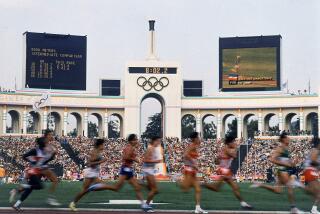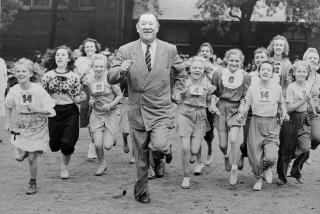Seagren Clears Air in Pole Controversy
One part of Bob Seagren would like to say that the reason he didn’t win his second consecutive gold medal in the pole vault in 1972 was an International Amateur Athletic Federation ruling that prevented him from competing with his regular poles.
But, today, the other admits that breezy, misty conditions on the day of the Olympic final would have made it difficult for him to clear 18 feet using his regular poles.
“Having to vault on [poles that weren’t mine] might have been a blessing in disguise because of the conditions,” said Seagren, 56. “If I had been allowed to jump on my regular poles, I might have been too aggressive and ended up [failing to clear a height].”
Seagren, a USC graduate, had cleared a world-record 18-5 3/4 in winning the U.S. Olympic trials in Eugene, Ore., on July 2. But three weeks later, the IAAF banned the poles that Seagren and many other vaulters, including U.S. teammate Jan Johnson, were using.
The IAAF contended that the newly developed poles had carbon fibers in them, making the implements lighter but just as strong as older-model poles. It also said that some of the world’s top vaulters, such as Seagren, had easier access to the poles than others, such as Wolfgang Nordwig of East Germany.
George Moore, a representative of the company that manufactured the banned Cata-Pole 550+, produced documents alleging that there were no carbon fibers in the pole and that all of the world’s top vaulters had received some of them.
Seagren, now in his second year as the chief executive officer of International City Racing after appearing in several episodic television series during the 1970s and ‘80s, wasn’t concerned with the ban because he was confident he could vault equally well on his poles deemed legal for competition.
But the IAAF, using methods that were highly questionable, according to Track & Field News magazine, mistakenly banned many “legal” poles during an implement inspection the day before the qualifying round.
In the final, Seagren cleared 17-8 1/2, finishing second behind Nordwig, who cleared an Olympic-record 18- 1/2 to become the first non-American to win an Olympic gold medal in the pole vault.
Johnson won the bronze medal at 17-6 3/4. The Illinois native is now one of the nation’s most respected pole-vault coaches. He conducts four vault camps a year from his home in Atascadero and holds annual camps in four other states.
“To clear 18 feet in those conditions was quite an accomplishment,” Seagren said. “But I was very upset at the time.”
More to Read
Go beyond the scoreboard
Get the latest on L.A.'s teams in the daily Sports Report newsletter.
You may occasionally receive promotional content from the Los Angeles Times.








